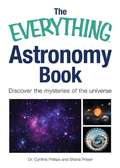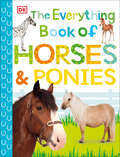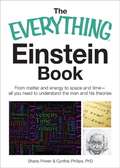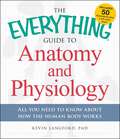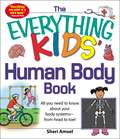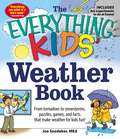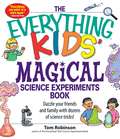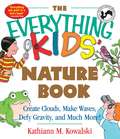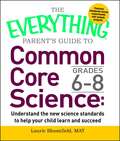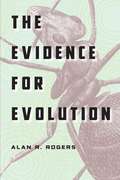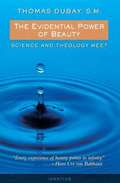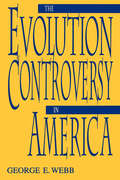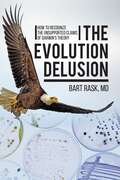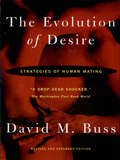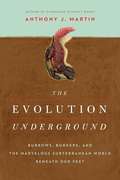- Table View
- List View
The Everything Astronomy Book
by Shana Priwer Dr Cynthia PhillipsThe Everything Astronomy Book, by noted SETI Institute scientist Dr. Cynthia Phillips, helps you stargaze with authority. The book not only provides clear descriptions of all the theories of the origins of the universe, it explains the facts about the planets, moons, and stars in language anyone can understand-completely free of the usual astro-jargon. In addition, common myths are debunked: Find out why the Big Dipper is not an actual constellation, and that a shooting star isn't really a star at all!
The Everything Astronomy Book: Discover the mysteries of the universe
by Dr Cynthia PhillipsThe Everything Astronomy Book, by noted SETI Institute scientist Dr. Cynthia Phillips, helps you stargaze with authority. The book not only provides clear descriptions of all the theories of the origins of the universe, it explains the facts about the planets, moons, and stars in language anyone can understand-completely free of the usual astro-jargon. In addition, common myths are debunked: Find out why the Big Dipper is not an actual constellation, and that a shooting star isn’t really a star at all!
The Everything Book of Horses and Ponies (Everything About Pets)
by DKA must-have for every animal-loving child, this is the cutest introduction to everything kids want to know about horses and ponies.Do you dream about riding a horse and want to really get to know them? Would you like to learn how to look after a horse, what kit to use, or enter the world of equestrian sports? Discover the secrets of gorgeous horses and ponies in this fun, lively book. Packed with colorful photos, fur-tastic facts, and bite-sized information, The Everything Book of Horses and Ponies takes you into their fascinating world. Find out about favorite breeds from Shire horse to Shetland pony. Learn about horses and ponies from around the globe, and be amazed by their beautiful colorings and patterns. Young equine enthusiasts will be champing at the bit to read this wonderful treasury of horses and ponies.
The Everything Einstein Book
by Shana PriwerAlbert Einstein was the most famous and influential thinker of his time. His theories of relativity, quantum mechanics, and statistical physics gave birth to a new era in scientific thought and changed the ay people see the universe and their place in it. The Everything Einstein Book walks you through his rise from a lowly patent clerk to a groundbreaking scientist and explains the theories that brought him fame and world renown. Covering everything from photoelectric effect to the unified field theory, this book answers all your questions about the genius, his work, and the age that influenced him.
The Everything Einstein Book: From Matter and Energy to Space and Time, All You Need to Understand the Man and His Theories
by Shana PriwerA Simon & Schuster eBook. Simon & Schuster has a great book for every reader.
The Everything Guide to Anatomy and Physiology (The Everything®)
by Kevin LangfordA plain-English guide to the human body and how it worksLooking for a companion text for your anatomy and physiology class? Need a refresher for a course you took years ago? Or are you just interested in learning more about how the human body works? Professor Kevin Langford walks you through all the structures of the body, from cells to organs to systems and how they interact. This all-in-one guide covers all you need to know about anatomy and physiology, including:Scientific terminology for organs, systems, and functionsThe functions of each system in the bodyHow systems are formed, from conception through adulthoodDiseases and disorders that affect each system With simple explanations and dozens of illustrations, The Everything Guide to Anatomy and Physiology provides a detailed look into the wonders of the human body.
The Everything KIDS' Human Body Book: All You Need to Know About Your Body Systems - From Head to Toe!
by Sheri AmselA book about the most interesting thing on earth--you!What happens to food after you eat it? Why is your blood red? How do your bones grow?Your body is an amazing machine. Every second of the day and night--without you even knowing it--your body is busily working to keep you running smoothly. When you think about how complicated the human body is and how little goes wrong, it is really an incredible feat! So how does your body do it all?The Everything Kids' Human Body Book is the expert answer to all your questions--from the tips of your toes to the top of your head, you will learn the hows and whys of the human body. Author Sheri Amsel takes you on a journey through the body, with information on:The muscles--from your biceps to your heartYour nerves and how they transmit messagesHow your skin heals itselfBones, joints, and other things you shouldn't breakBlood, guts, and the circulation systemHow your body digests food (it's not always pretty!)Why you need air and how breathing works With more than 30 different puzzles and games about the human body, plus information on how to take care of your own body with good nutrition, exercise, and more, The Everything Kids' Human Body Book is the ultimate way to learn how the body works--inside and out!
The Everything KIDS' Weather Book: From Tornadoes to Snowstorms, Puzzles, Games, and Facts That Make Weather for Kids Fun! (Everything Kids)
by Joseph Snedeker<p>Get ready for a 100% chance of scientific fun! <p>Have you ever wondered what happens in the eye of a tornado or how hurricanes gain their strength? From lightning and snow-day blizzards to rainbows and monsoons, The Everything Kids' Weather Book gives you an exciting look into all the action that happens in the sky, including: The difference between cirrus and stratocumulus clouds; How meteorologists predict the weather; What the term "a perfect storm" means; How to build a weather station of your own; Why storms depend on how cold and warm fronts interact; How to create weather experiments at home; The effects of global warming on our planet. <p>Filled with hundreds of exciting facts and thirty fun weather puzzles and games, The Everything Kids' Weather Book is perfect for finding out how a barometer works, which cloud is a nimbus cloud, what causes hailstorms - and everything in between!
The Everything Kids' Easy Science Experiments Book: Explore the world of science through quick and fun experiments! (Everything® Kids)
by J. Elizabeth MillsWhy is the sky blue? What makes a balloon float? Why can't I see in the dark?You can discover the answers to these questions and more with The Everything Kids' Easy Science Experiments Book. Using easy-to-find household materials like soda bottles and flashlights, you can build bubbles, create plastic--even make raisins dance! All of the experiments are kid-tested and educational--but more importantly, they're tons of fun! These quick and easy experiments help you to:Explore your five senses.Discover density and sound.Delve into seasons, life cycles, and weather.Investigate electricity and light.Study the solar system and landforms.Examine matter and acids/bases. This is the perfect book for a rainy Saturday, a lazy vacation day, or even after school. You'll have so much fun conducting the experiments, you'll forget that you're actually learning about science!
The Everything Kids' Magical Science Experiments Book
by Tim Robinson"The Everything Kids' Magical Science Experiments Book" is filled with over 50 science experiments that bend the rules of time, space and logic so far, they appear to be magical.Kids can conduct these experiments safely in the home, unlocking the mysteries of experiments that: you can create using common food items; will help you explore the "magic" of heating and cooling; you can conduct in your front or back garden; have to do with the senses and human body; probe physical processes and changes; and, delve into chemical and biological processes and changes.Packed with 30 "magical" science-related puzzles and over 50 experiments that are sure to get kids excited about chemistry, science and physics, "The Everything Kids' Magical Science Experiments Book" is the perfect tool for anyone who is awed by the magic of science.
The Everything Kids' Magical Science Experiments Book: Dazzle your friends and family by making magical things happen!
by Tim RobinsonDazzle your friends and family with dozens of science tricks!Kids may not clamor to study science and physics, but they sure enjoy anything that has to do with slime, invisible ink and obtaining the ability to make things disappear. With The Everything Kids' Magical Science Experiments Book, kids will be able to bend the rules of time, space and logic by performing over 50 "magical" science experiments. Parents will love the fact that their kids are learning while having fun, by performing feats such as:Changing salt to sugarCreating a real life genie in a bottleCreating and writing with invisible inkMaking a person stay seated, just by using their pinky fingerSealing a punctured balloon with a pennyChanging Mentos candy into sodaThe Everything Kids' Magical Science Experiments Book is packed with 30 "magical" science-related puzzles and over 50 experiments that are sure to get kids excited about chemistry, science and even physics!
The Everything Kids' Nature Book
by Kathiann M. KowalskiKids love nature, and with The Everything Kids' Nature Book, they'll keep busy for hours. Packed with information and activities, kids will: roam the natural world of their own backyard; discover how birds, bats, and bugs pollinate the landscape; learn about life on the edge of the sea; and more!
The Everything Kids' Nature Book: Create Clouds, Make Waves, Defy Gravity and Much More!
by Kathiann M KowalskiThe natural world holds secrets under every rock and around every tree. If you've ever wondered what life is like through a microscope, telescope, or with the naked eye--you'll love this book!You will:Run with the antelope across the American plains and learn about the food chain.Climb with a monkey to the highest tree in the rainforest and discover how photosynthesis keeps leaves green.Sink to the bottom of the ocean to follow creatures who have adapted to life in total darknessTravel with a meteor at speeds up to 160,000 miles per hour.Burrow with the earthworms in your own backyard. Through it all, you'll find out how things synergize, regenerate, and evaporate--and lots more! And don't worry about the big words--they are all defined and explained with familiar examples in this fascinating trip through the natural world.
The Everything Kids' Science Experiments Book: Boil Ice, Float Water, Measure Gravity-Challenge the World Around You! (Everything® Kids)
by Tom RobinsonScience has never been so easy--or so much fun! With The Everything Kids' Science Experiments Book, all you need to do is gather a few household items and you can recreate dozens of mind-blowing, kid-tested science experiments. High school science teacher Tom Robinson shows you how to expand your scientific horizons--from biology to chemistry to physics to outer space. You'll discover answers to questions like: Is it possible to blow up a balloon without actually blowing into it? What is inside coins? Can a magnet ever be "turned off"? Do toilets always flush in the same direction? Can a swimming pool be cleaned with just the breath of one person? You won't want to wait for a rainy day or your school's science fair to test these cool experiments for yourself!
The Everything Parent's Guide to Common Core Science Grades 6-8: Understand the New Science Standards to Help Your Child Learn and Succeed
by Laurie BloomfieldTake the mystery out of middle-grade science!The Common Core, a new set of national educational standards, has been adopted by 45 states across the nation. But if you learned about science the "old" way, you may be having a hard time understanding what your kids are bringing home from school--and why. With information on Next Generation Science Standards and practice exercises and experiments, you'll learn:The rationale behind Common Core standardsThe major scientific concepts your child will be learning at each grade levelThe new requirements for learning concepts and applying them in practical waysHow the Next Generation Science Standards relate to the Common Core Math and English Language Arts standardsHow to help your child with homework and studyingThe Everything Parent's Guide to Common Core Science: Grades 6-8 will give you the confidence to help your kids meet the science expectations for their grade level, excel at school, and prepare for high school and beyond.
The Everything® Astronomy Book
by Cynthia Phillips Shana PriwerThe Everything Astronomy Book, by noted SETI Institute scientist Dr. Cynthia Phillips, helps you stargaze with authority. The book not only provides clear descriptions of all the theories of the origins of the universe, it explains the facts about the planets, moons, and stars in language anyone can understand-completely free of the usual astro-jargon. In addition, common myths are debunked: Find out why the Big Dipper is not an actual constellation, and that a shooting star isn’t really a star at all!
The Everything® Einstein Book
by Cynthia Phillips Shana Priwer- His childhood curiosities and unusual education- The scientific climate of Einstein's time and the people who influenced him- His theories, their impact, and their potential for future application- Einstein's philosophies on war, religion, and pacifism- Einstein in America
The Everything® Kids' Magical Science Experiments Book
by Tom RobinsonKids love magic'and they also love making cool science projects. Now they can do both at the same time! With The Everything? Kids? Magical Science Experiments Book, kids can bend the rules of time, space, and logic by performing more than 50 ?magical? and awe-inspiring science experiments. Inside, kids learn such tricks as: ? Changing salt to sugar ? Summoning a real life genie in a bottle ? Creating and writing with invisible ink ? Making a person stay seated, just by using their pinky finger ? Sealing a punctured balloon with a penny ? Turning candy into soda And parents will love the fact that their kids are learning while having fun with The Everything? Kids? Magical Science Experiments Book.
The Everything® Kids' Nature Book
by Kathiann M. KowalskiThe Everything "RM" Kids' series is being relaunched at a phenomenal new price! They're the same great quality you've come to expect, still packed with tons of activities and puzzles in two-color -- now with a lower price that everyone can appreciate!Stock up on these perennial bestsellers that keep your kids active and engaged. The wide scope of subject material -- from jokes to science experiments -- appeals to kids all across the country. And parents and teachers love that the books provide responsible, educational information, while being so much fun that the kids love learning!From discovering why a sunset is red, to becoming a young entrepreneur, to learning new jokes to keep the whole family laughing, kids really love these Everything "RM" Kids' books!
The Evidence for Evolution
by Alan R. RodgersAccording to polling data, most Americans doubt that evolution is a real phenomenon. And it’s no wonder that so many are skeptical: many of today’s biology courses and textbooks dwell on the mechanisms of evolution—natural selection, genetic drift, and gene flow—but say little about the evidence that evolution happens at all. How do we know that species change? Has there really been enough time for evolution to operate? With The Evidence for Evolution, Alan R. Rogers provides an elegant, straightforward text that details the evidence for evolution. Rogers covers different levels of evolution, from within-species changes, which are much less challenging to see and believe, to much larger ones, say, from fish to amphibian, or from land mammal to whale. For each case, he supplies numerous lines of evidence to illustrate the changes, including fossils, DNA, and radioactive isotopes. His comprehensive treatment stresses recent advances in knowledge but also recounts the give and take between skeptical scientists who first asked “how can we be sure” and then marshaled scientific evidence to attain certainty. The Evidence for Evolution is a valuable addition to the literature on evolution and will be essential to introductory courses in the life sciences.
The Evidential Power of Beauty
by Thomas DubayWhile everyone is delighted by beauty, and the more alive among us are positively fascinated by it, few are explicitly aware that we can recognize truth by its beauty and simplicity. Dubay explores the reasons why all of the most eminent physicists of the twentieth century agree that beauty is the primary standard for scientific truth. Likewise, the best of contemporary theologians are also exploring with renewed vigor the aesthetic dimensions of divine revelation. Honest searchers after truth can hardly fail to be impressed that these two disciplines, science and theology, so different in methods, approaches and aims, are yet meeting in this and other surprising and gratifying ways. This book relates these developments to nature, music, academe and our unquenchable human thirst for unending beauty, truth and ecstasy, a thirst quenched only at the summit of contemplative prayer here below, and in the consummation of the beatific vision hereafter.
The Evolution Controversy in America
by George E. WebbA comprehensive intellectual history of America’s century-old debate over teaching evolution in public schools.For well over a century, the United States has witnessed a prolonged debate over the teaching of organic evolution in the nation’s public schools. The controversy that began with the publication of Darwin’s Origin of the Species had by the 1920s expanded to include theologians, politicians, and educators. The Scopes trial of 1925 provided the growing antievolution movement with significant publicity and led to a decline in the teaching of evolution.In The Evolution Crisis in America, George E. Webb details how efforts to improve science education in the wake of Sputnik resurrected antievolution sentiment and led to the emergence of “creation science” as the most recent expression of that sentiment. Creationists continue to demand “balanced treatment” of theories of creation and evolution in public schools, even though their efforts have been declared unconstitutional in a series of federal court cases. Their battles have been much more successful at the grassroots level, garnering support from local politicians and educators. Webb attributes the success of creationists primarily to the lack of scientific literacy among the American public.
The Evolution Delusion: How to Recognize the Unsupported Claims of Darwin's Theory
by Bart RaskDoes the field of evolution differ from other sciences? The author, a reviewer for a major medical journal, scrutinized hundreds of scientific references in evolutionary literature, adopting the same standards used for studies submitted for medical public
The Evolution Of Desire - Revised
by David M. BussWith two new chapters by the author.If we all want love, why is there so much conflict in our most cherished relationships? To answer this question, says noted psychologist David Buss, we must look into our evolutionary past. Based on the most massive study of human mating ever undertaken, encompassing more than ten thousand people of all ages from thirty-seven cultures worldwide, The Evolution of Desire is the first book to present a unified theory of human mating behavior. Now in a revised and updated edition, Buss's classic presents the latest research in the field, including startling new discoveries about the evolutionary advantages of infidelity, orgasm, and physical attractiveness.
The Evolution Underground: Burrows, Bunkers, and the Marvelous Subterranean World Beneath our Feet
by Anthony J. MartinWhat is the best way to survive when the going gets tough? Hiding underground. From penguins to dinosaurs, trilobites, and humans, Anthony Martin reveals the subterranean secret of survival. Humans have “gone underground” for survival for thousands of years, from underground cities in Turkey to Cold War–era bunkers. But our burrowing roots go back to the very beginnings of animal life on earth. Without burrowing, the planet would be very different today. Many animal lineages alive now—including our own—only survived a cataclysmic meteorite strike 65 million years ago because they went underground. On a grander scale, the chemistry of the planet itself had already been transformed many millions of years earlier by the first animal burrows, which altered whole ecosystems. Every day we walk on an earth filled with an under-ground wilderness teeming with life. Most of this life stays hidden, yet these animals and their subterranean homes are ubiquitous, ranging from the deep sea to mountains, from the equator to the poles. Burrows are a refuge from predators, a safe home for raising young, or a tool to ambush prey. Burrows also protect animals against all types of natural disasters: fires, droughts, storms, meteorites, global warmings—and coolings. In a book filled with spectacularly diverse fauna, acclaimed paleontologist and ichnologist Anthony Martin reveals this fascinating, hidden world that will continue to influence and transform life on this planet.
